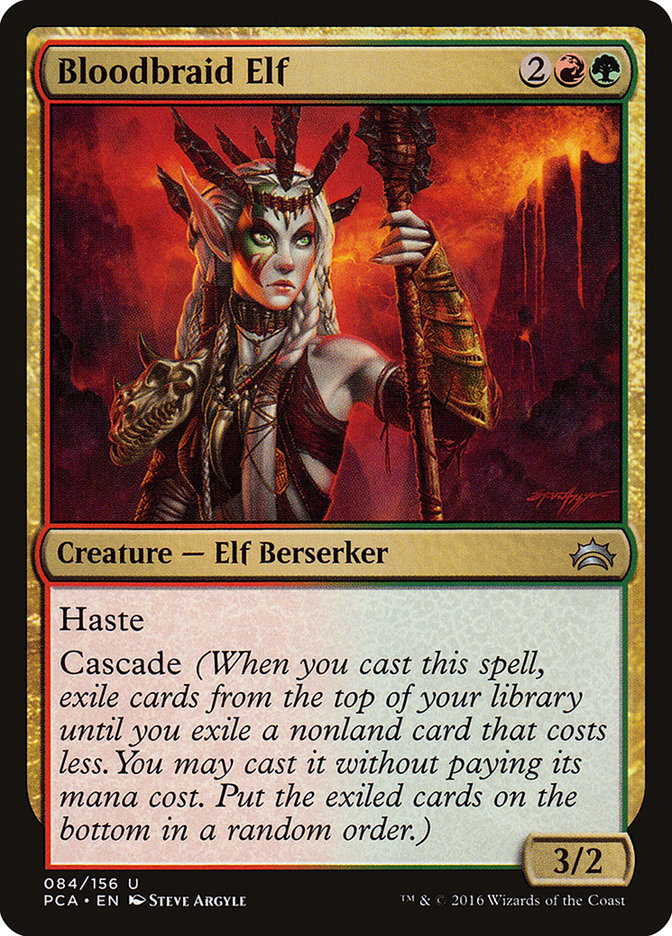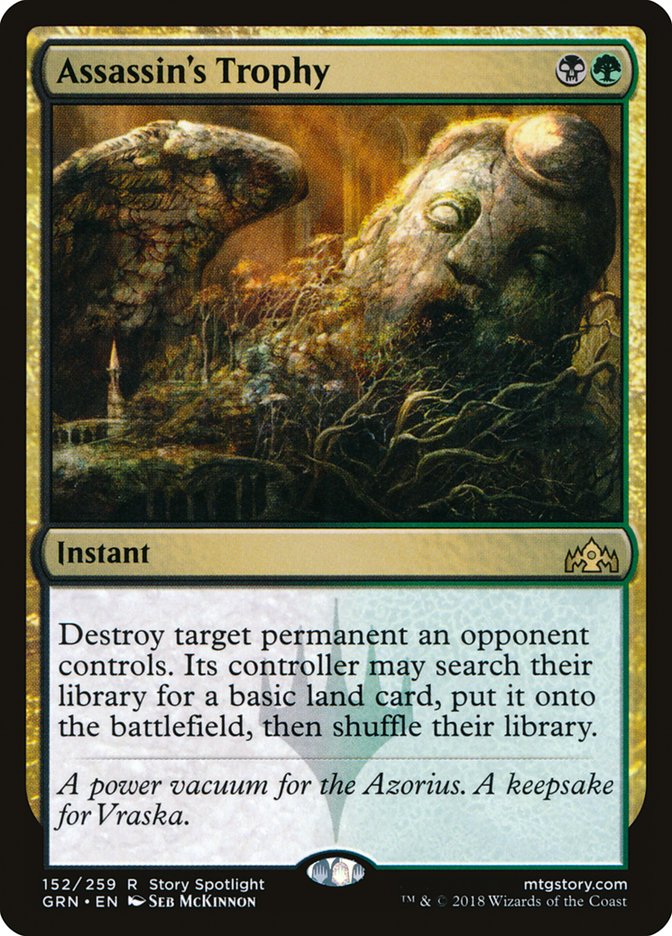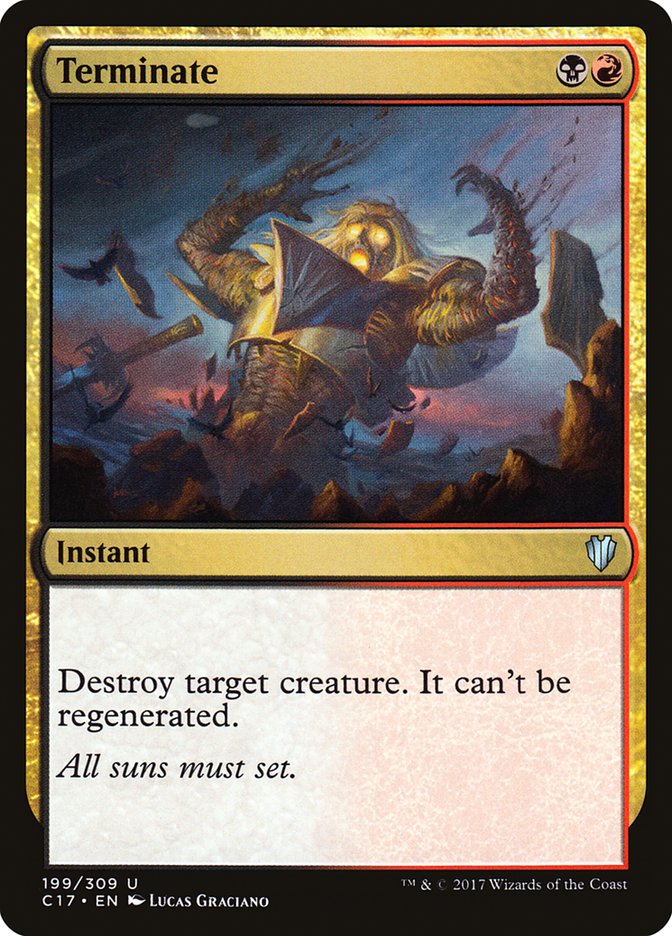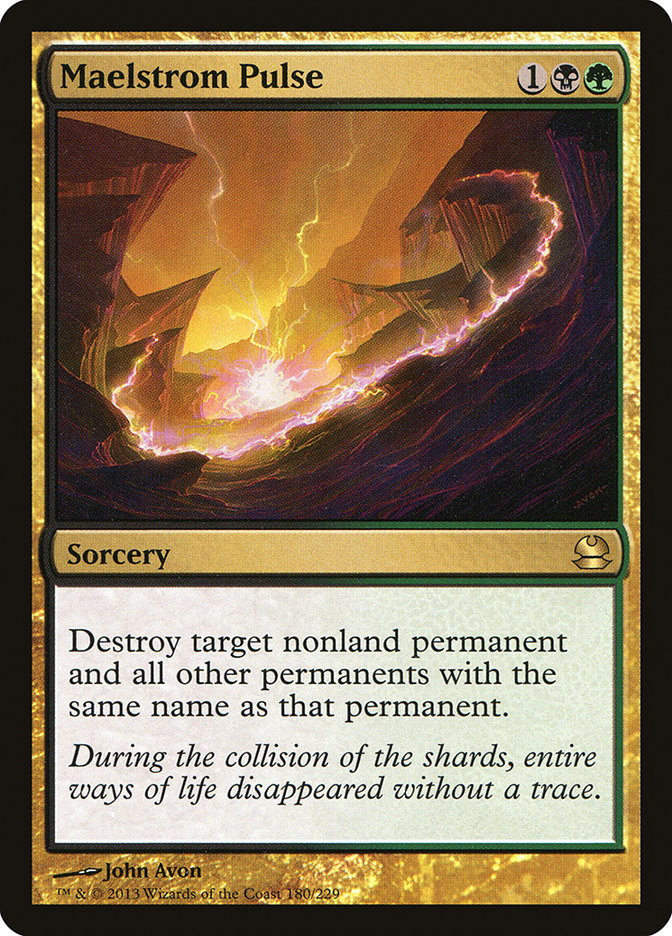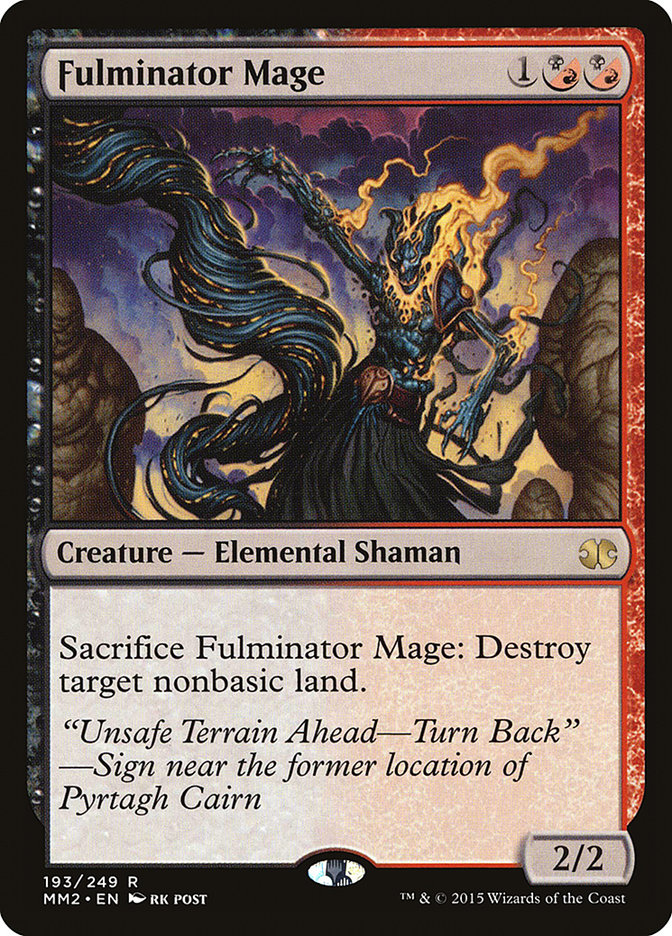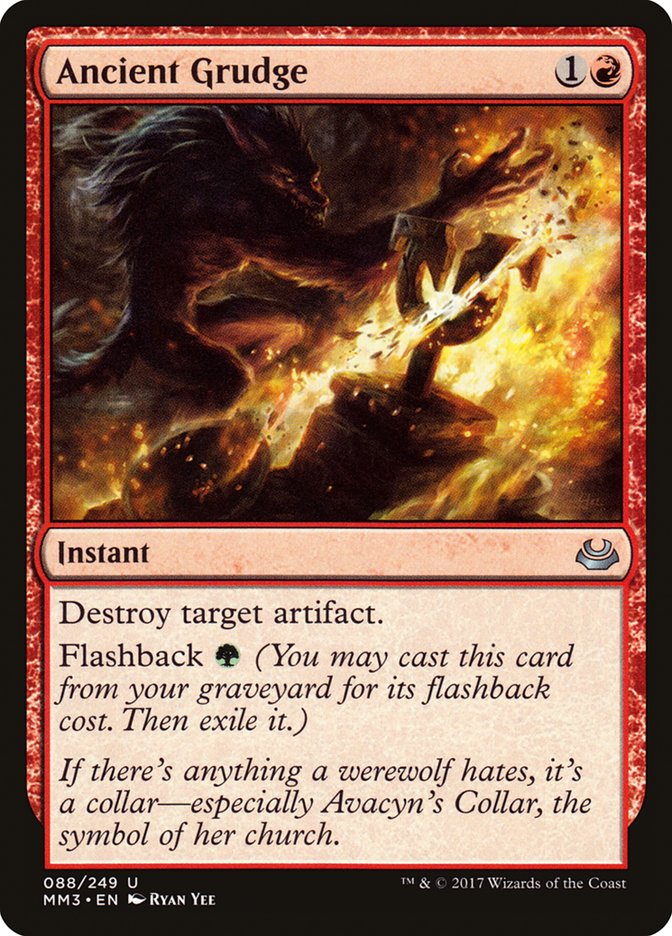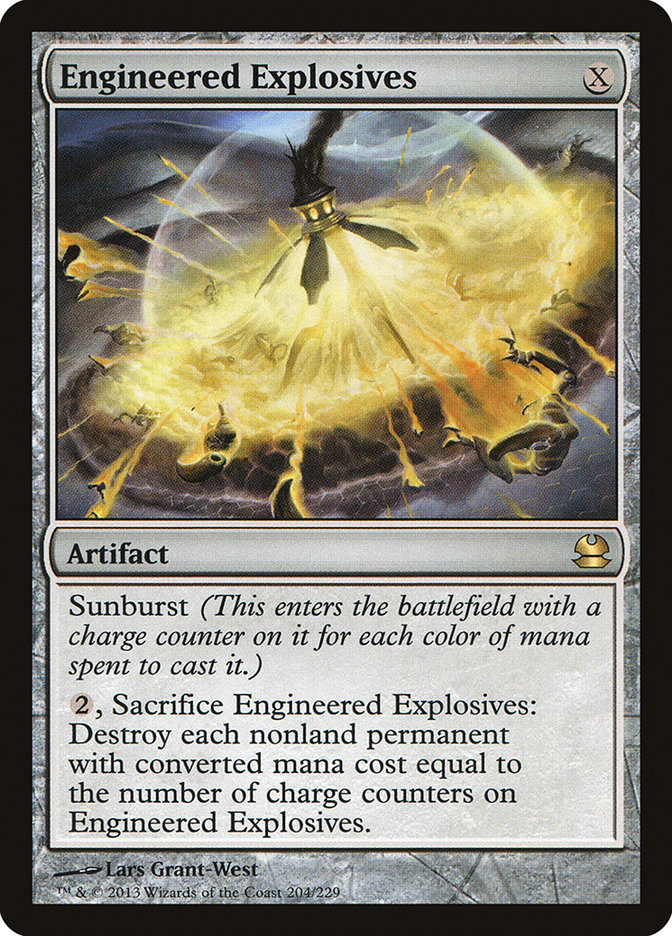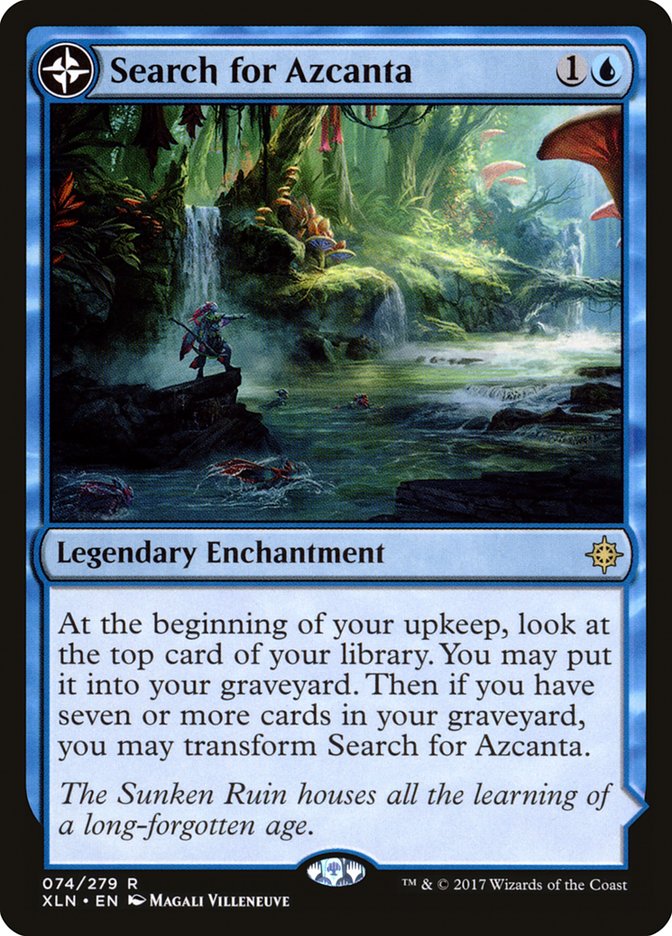You know, I could grow used to this.
It started when they unbanned my old friend Bloodbraid Elf. I got to write
an article talking about how she was the solution to all Jund’s problems
and how Jund would change to accommodate her. Then I got to a win a bunch
at Magic tournaments by casting her. It was a good time, to be honest.
Then things started to change. The Modern metagame shifted and wins with
Jund got harder to come by. People were no longer surprised to see your
Raging Ravines and no one was ever caught off guard by a Liliana of the
Veil. Whispers of Jund’s demise became fact more or less overnight. Things
got so bad I couldn’t in good faith let the tournament results of my
friends depend on Jund and instead played Burn in Team Unified Modern at
Grand Prix Detroit.
Now, the cycle begins anew. Not an unbanning this time, but an altogether
new card. Assassin’s Trophy changes everything. Once again, all
Jund’s problems have been solved. Once again, Jund builds will have to
change drastically to accommodate a new toy. Once again, I get to write
about the new face of Jund, and very soon I will once again get to win a
lot of matches with Tarmogoyf and friends.
And this time, I expect Jund’s life expectancy to be longer. Much longer.
Problems Solved
Take a look at the recent Jund list that won #SCGINDY a few
months back:
Creatures (14)
Planeswalkers (4)
Lands (23)
Spells (19)

Here’s what I want you to hone in on:
Once upon a time, before Bloodbraid Elf got unbanned but after the Jund
glory days, I was asked what my least favorite card in my favorite deck
was. My answer was quick: Abrupt Decay. Many people love Abrupt Decay for
its flexibility, I hate it for its limitations. Losing to a four-mana card
with an Abrupt Decay in hand is one of the worst feelings in the world, and
the card doesn’t even make good mana exchanges to compensate. Terminate can
trade up in mana but is limited to being helpful when you’re losing to
creatures. Maelstrom Pulse will solve any problem, but three-mana sorceries
are a rough place to be in Modern.
The truth of the matter is that these cards were necessary evils in Jund.
Midrange decks in Modern have it rough. They don’t win fast enough to
ignore what the opponent is trying to do, and what opponents in Modern are
trying to do is rarely simple. Decks attack from several angles and present
a wide-range of troublesome permanent types. Maybe in the past Thoughtseize
and Lightning Bolt were enough to handle the problems presented by every
deck in the format, but those days are long past.
Thus, we dutifully play our one or two copies of Maelstrom Pulse. We sit
and have a long think about whether we’d rather lose to Reality Smasher or
Cranial Plating this weekend and decide on our Abrupt Decay / Terminate
split accordingly. We do what we must to have game against the field as a
whole, but we’re not happy about it.
The unique demands of Modern do more than shape our last few maindeck
slots. They force us to double-down on niche forms of removal in the
sideboard. Plenty of artifact removal to handle Ironworks and Affinity.
Fulminator Mage to deal with Tron and U/W Control. The Jund sideboard is
unbelievably taxed, chock-full of cards that interact in unique ways and
have applications against several decks. Flexibility is prized above all
else because Jund is forced to have a sufficient quantity of interaction
after sideboard against decks that don’t rely solely on simple creatures.
This problem has only grown worse over time.
I used to love the Azorious Control and Jeskai Control matchup. It
was challenging to play proficiently but learning to do so was extremely
rewarding. They had cards you could almost never beat, like Elspeth, Sun’s
Champion and Sphinx’s Revelation, but they all cost so much mana that you
had a plethora of ways to answer them before they were cast. But with the
printing of Search for Azcanta and the widespread adoption of Jace, the
Mind Sculptor and Teferi, Hero of Dominaria, the number of relatively cheap
spells that invalidate the Jund strategy has grown out of control.
Azorious Control and Jeskai Control are just two matchups in the sea of
matchups that is Modern, but their stories are a representative microcosm
of the format as a whole. The range of threats that needs to be answered is
wider than ever, and the price for stumbling in doing so is massive.
Drawing Abrupt Decay when what you needed was Terminate spells certain
doom, as does drawing Kolaghan’s Command when you needed a Maelstrom Pulse.
Jund’s situational answers to diverse permanent types have been its biggest
weakness in current Modern.
Enter Assassin’s Trophy.
I know I needed two looks to be sure I wasn’t dreaming.
This card answers everything. Urza’s Tower. Jace, the Mind
Sculptor. Cranial Plating. Hardened Scales. Mantis Rider. Thought-Knot
Seer. Every troublesome permanent that has ever beaten you, all answered in
a two-mana instant. The days of hedging are over. There’s no need to choose
to lose to Cranial Plating to beat Reality Smasher when you can just beat
both of them, and that ability is exactly what Assassin’s Trophy delivers.
I could go on forever about how good Assassin’s Trophy is, but I get the
sense that I don’t need to. The card is powerful, and it will be played.
The key point I want to drive home is that the strength of Assassin’s
Trophy in Jund isn’t just due to the card’s raw power level. No, Trophy’s
completely unprecedented flexibility is what has huge ramifications for how
the Jund deck is built and how successful it will be going forward.
For starters, Jund’s sideboard will change drastically. The flexibility we
so desperately needed before is now superfluous. With Assassin’s Trophy
taking the slot of less flexible cards in the maindeck, we can be assured
of having ample interaction for every opposing strategy without having
seven or eight cards to bring in. This paves the way for Jund to get more
mileage out of its sideboard and include more singularly powerful but
narrow effects.
Some of Jund’s historically awful matchups will swing on the spot. Tron,
for instance. Without having actually played the matchup I can’t say for
sure, but I would not be at all surprised if Assassin’s Trophy made the
matchup favorable for Jund. A modal spell that can either take
them off Tron or answer any of their massive threats is a huge boon for
Jund players everywhere.
Problems Created
But like I said, I’m not here to convince you of the power of Assassin’s
Trophy. I’m here to discuss how Jund lists will adapt to best take
advantage of the powerful new option at their disposal. It’s time to talk
about the downside of Assassin’s Trophy. The card is going to be a player
in multiple formats and revolutionize Modern Jund, but two-mana Vindicate
it is not.
Lategame, Assassin’s Trophy is the best removal spell for a Jund player to
have in hand. Jund actively wants to reduce the game to a topdeck war, and
once that mission has been accomplished Assassin’s Trophy has close to no
downside. Until then, that downside is a huge problem. Luckily,
it’s a downside that Modern already has a great deal of experience with:
It’s obvious that giving your opponent a land is something that, all things
being equal, you would rather not do. Of course, other things aren’t equal and Path to Exile sees widespread play, establishing
the historical precedent that removing any creature is worth the price of
giving your opponent an extra basic land. It’s important to note, however,
that the downside varies in importance from deck to deck.
Aggressive decks playing Path to Exile rarely notice the downside on the
card. If the extra land isn’t letting the opponent cast Wrath of God a turn
later, the extra land isn’t going to do them much good. And since the decks
that play Wrath of God and the decks that play creatures worth using Path
to Exile on are rarely one and the same, Path to Exile is almost free in
these decks.
Control decks playing Path to Exile have the game plan of answering
everything their opponents try to do and giving them plenty of time in
which to do it. As such, extra lands aren’t of extreme importance, although
control decks do strongly prefer to cast Path to Exile later rather than
sooner to ensure they don’t fall behind in tempo and lose the game as a
result. But even when they do have to Path early and fall behind in tempo,
they play plenty of cards capable of catching back up.
Abzan is the deck closest to Jund that plays Path to Exile, and it falls
solidly between aggro and control. Like a control deck, it intends to give
its opponents plenty of turns to try to execute their game plan. Like an
aggro deck, it has few ways to catch up in a game its fallen behind in,
tempo-wise. This leaves Path to Exile in an awkward spot where early Path
to Exiles can spell disaster. It’s no accident that the printing of Fatal
Push saw a heavy reduction in the number of Path to Exile found in Abzan
lists. The downside is at its worst in the Golgari-based archetype.
To illustrate this point in another way, let’s think about the role of
Liliana of the Veil and Thoughtseize in Jund and Abzan. Taken together,
these cards indicate a strong desire to deal with cards the opponent has before they get to cast them. Every Jund pilot knows the pain of
drawing a Thoughtseize after their opponent has no cards left in hand;
giving the opponent an extra land in the early game lets them deploy all
their cards faster, reducing the window of time in which discard is
effective. This is a problem.
It’s not an insurmountable problem. Assassin’s Trophy is very good,
downside or no downside. Still, we don’t want to be casting the card on
turn two. Giving our opponent a Rampant Growth early in the game is
extremely counterproductive to the Jund plan. Trophy is fantastic late,
miserable early.
To me, this means that we don’t want to play four copies of the card.
Drawing two copies in my opening hand sounds awful. Ideally, I want to draw
Assassin’s Trophy on turn three or four; early enough to make an impact on
my opponent’s plans, late enough that I’ve gotten plenty of mileage out of
all the discard I’ve crammed into my deck. Three copies is where I plan to
start, although I could envision two being correct; likely with additional
copies in the sideboard.
Barring radical changes to the shape of the Modern format, I don’t believe
it likely that any copies of Abrupt Decay, Terminate, Dreadbore, or
Maelstrom Pulse should be in Jund after Guilds of Ravnica. If the
format ever narrows to a point where any of these cards are reliably your
best answer against most of the format, it would absolutely be right to
play them over Assassin’s Trophy. I don’t think that will happen.
The Jund of the Future
Moving forward with Jund, here’s the things I’m thinking about:
-
The need for speed has decreased. It certainly isn’t gone entirely,
but with the bump in interaction against unfair decks granted by
Assassin’s Trophy, closing speed no longer must be the number one
priority. Fairly uninterested in kill-em-quick sideboard cards like
Hazoret the Fervent. -
Fulminator Mage may be a relic and it has at the very least
declined drastically in importance. Assassin’s Trophy can deal with
Urza’s Tower, Azcanta, the Sunken Ruin, and Celestial Colonnade.
I’m going to start with two Fulminator Mages but intend to watch
and see if they can be cut altogether. -
I want my non-Assassin’s Trophy interaction to be good early. Given
the option, I want to cast my Trophys late, which means I need
other things to do the heavy lifting in the early game. I can’t see
going below five pieces of one-mana removal. -
Basic Mountain is unplayable. Without Terminate / Dreadbore giving
an early Mountain something to cast, I have no desire to have a
Mountain in my deck. The fourth Lightning Bolt can also be
dispensed with since we no longer need to max out our closing
speed. Bias the deck away from red. -
The sideboard has a lot of room to change, and I expect we’ll see a
lot of innovations in the first few months post-Guilds of Ravnica. Be open to new plans and keep an open mind.
With all that being said, here’s my starting list:
Creatures (14)
Planeswalkers (5)
Lands (23)
Spells (18)

Happy Junding.


